A vivid re-enactment of a three-car collision on a California highway opened the Toyota Research Institute (TRI) press conference at the Consumer Electronics Show (CES). The presentation demonstrated how development of the Toyota Guardian automated safety system could help prevent this kind of incident.
Nobody was hurt in the above accident, as TRI chief executive officer Dr Gill Pratt explained: “We know what happened, because we were there, in the thick of it. Our test vehicle was travelling at freeway speed in manual mode, with its autonomy mode disabled as it gathered data. After we downloaded the data from the incident, we asked ourselves if this crash could have been mitigated or avoided altogether by a future Toyota Guardian automated safety system. We believe the answer is yes.”
Since starting its work three years ago, TRI has committed to a two-track development approach to automated driving. Its on-going Toyota Chauffeur programme focuses on fully autonomous operation, where the human is essentially removed from the driving equation, either completely or within a restricted domain. Toyota Guardian, on the other hand, is being developed to amplify human control of the vehicle, not replace it.
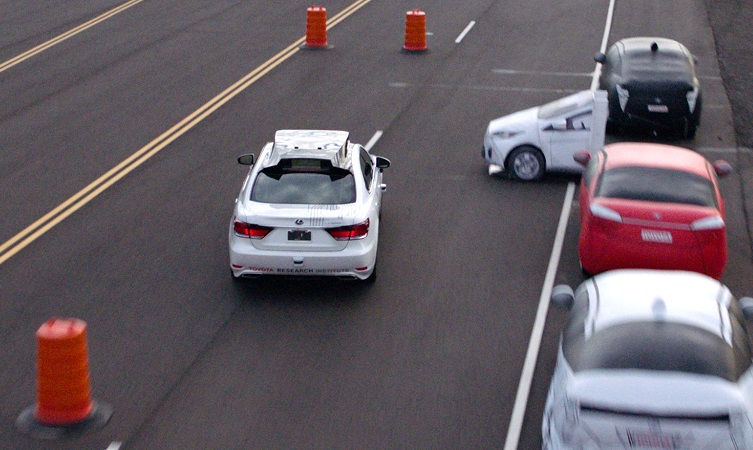
Scenario 1: Car pulls into the path of approaching car – view one
With Toyota Guardian, the driver is meant to be in control of the car at all times, except in those instances where the system anticipates or identifies a pending incident and employs a corrective response, in co-ordination with driver input.
One of TRI’s most significant breakthroughs of the past year was the creation of blended envelope control, where the Guardian system combines and co-ordinates the skills and strengths of the human and the machine. The system is inspired by the way modern fighter jets are flown: the pilot uses the control stick but they are not flying the plane directly; instead, their intentions are translated by a low-level flight control system thousands of times a second to keep the aircraft stable and within its safety envelope.
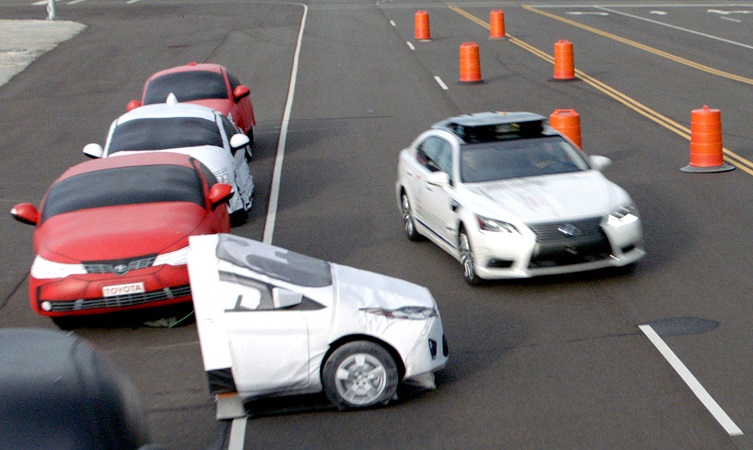
Scenario 1: Car pulls into the path of approaching car – view two
Toyota Guardian can operate with a human driver or an autonomous driving system
This type of system is more difficult to create in a car, because the control envelope is not only defined by vehicle dynamics but also the vehicle’s perception and prediction of everything in its immediate environment. Fundamentally, the idea is that this control envelope is not a discrete on-off switch between human and autonomous control but a seamless blend, working as teammates to extract the best input from both.
Toyota Guardian is being developed as an automated safety system that can operate with a human driver or an autonomous driving system. This is a key capability of the technology.
As Toyota president Akio Toyoda announced at CES last year, Toyota plans to include Toyota Guardian as standard equipment on all Toyota e-palette platforms that the company will build for the Mobility as a Service (MaaS) market. By doing so, MaaS fleet buyers can use any autonomous system they choose, with Toyota Guardian acting as a belt-and-braces redundancy for any self-driving Chauffeur system.
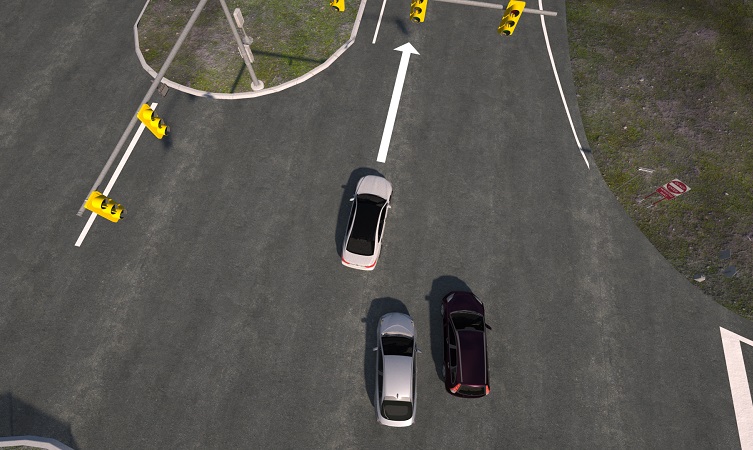
Scenario 2: Cars merging lanes at speed – view one
Pratt stressed the importance of not underestimating the difficulty of developing an autonomous Chauffeur system, both technologically and sociologically. Technically, how do we train a machine in the “social ballet” required to navigate an ever-changing environment, as well as, or better than a human driver? Sociologically, public acceptance of the inevitable incidents that will occur due to fully autonomous Chauffeur systems may take considerable time.
“In the meantime,” said Pratt, “we have a moral obligation to apply automated vehicle technology to save as many lives as possible, as soon as possible.”
This is why TRI’s primary focus in 2018 was to concentrate most of its efforts on making Toyota Guardian a smarter machine. For Guardian to learn and become smart, it must be subjected to difficult and demanding driving scenarios – known as ‘corner cases’ – that are simply too dangerous to perform on public roads. On closed courses, Guardian’s intelligence and capabilities can be stretched and challenged. Through continuous refinement, Guardian learns how best to navigate and react to dangerous scenarios as they unfold.
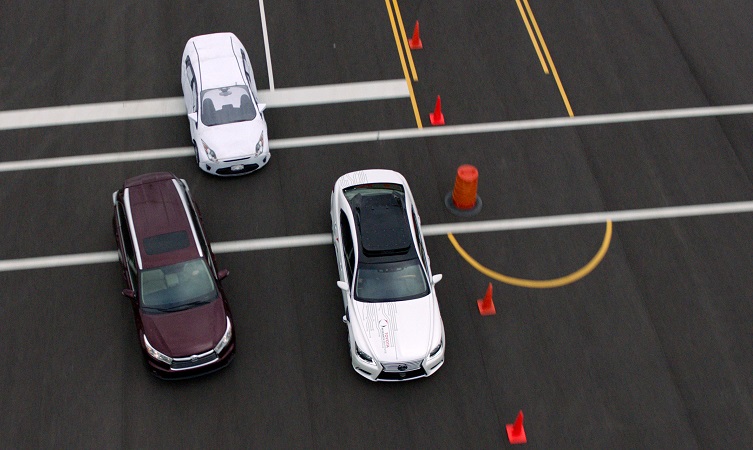
Scenario 2: Cars merging lanes at speed – view two
Guardian’s growing capability gives the three-car incident in California shown during the press conference an interesting twist. Here was an accidental corner case on a public highway – a dangerous crash that played out right in front of TRI’s sensors and cameras.
From the data gathered, TRI developed an accurate simulation that was then translated into a learning tool for the car to figure out its options in a split second. The scenario was recreated on a test track, using real vehicles and a guided, soft-target dummy car. In this instance, the Guardian’s best option was to quickly accelerate away from the encroaching vehicles. Here was a case where the Guardian might avoid or mitigate a collision for itself, while potentially doing the same for other nearby vehicles, effectively operating altruistically.
Pratt addressed another key capability that makes the Toyota Guardian even more evocative: “Humans have an inherent need for autonomy, which is much stronger than our desire for autonomous cars. It’s about the sheer delight of mobility, from when a child first learns to stand up and make their way across a room without help from mum or dad. And it is the joy of just going for a drive, behind the wheel of a car that can accelerate brake and turn as it is an extension of your body.”

Scenario 3: High-speed obstacle avoidance
The joy of driving is an inherent and deliberate component of Guardian. Hands on the wheel and eyes on the road is first and foremost about safety, but it is not all about safety. It is also about how a driver feels behind the wheel; safe and secure to enjoy the drive, instead of the ride.
It is also about the democratisation of safety, a philosophy Toyota pioneered almost three years ago when it began equipping cars with automatic emergency braking as standard.
“We think the most important benefit of automated driving is not about the autonomy of cars. It’s about the autonomy of people,” Pratt concluded.
Learn more: What is the Toyota Research Institute?
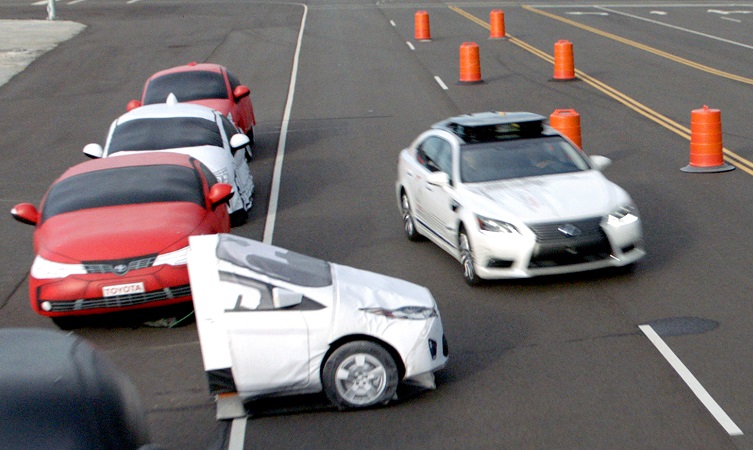




This system is so interesting. Thanks to all involved in the development process. I will continue to focus on this engineering.